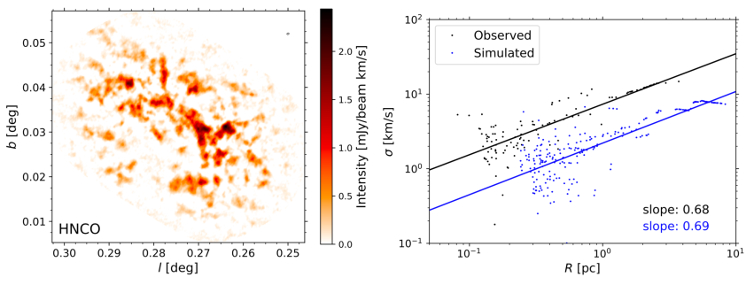| EPoS Contribution |
|
The complex multi-scale structure in simulated and observed emission maps of the proto-cluster cloud G0.253+0.016 ("the Brick")
Maya Petkova ARI/ZAH, Heidelberg, DE | |
| The Central Molecular Zone (CMZ; the central ~ 500 pc of the Milky Way) hosts molecular clouds in an extreme environment of strong shear, high gas pressure and density, and complex chemistry. G0.253+0.016, also known as "the Brick", is the densest, most compact and quiescent of these clouds. High-resolution observations with the Atacama Large Millimeter/submillimeter Array (ALMA) have revealed its complex, hierarchical structure. In this contribution I will compare the properties of recent hydrodynamical simulations of the Brick that include the effects of the Galactic potential to the properties of the ALMA observations. To facilitate the comparison, we post-process the simulations and create synthetic ALMA maps of molecular line emission from eight molecules. We find excellent agreement in the kinematics of the simulated and the observed data in terms of the size-linewidth relation, the rotation of the cloud and its turbulent state. In addition, we characterise the spatial structure of the observed and simulated cloud using the density probability distribution function (PDF), spatial power spectrum, fractal dimension, and moments of inertia. While we find good agreement between the observed and simulated data in terms of power spectra and fractal dimensions, there are key differences in the density PDFs and moments of inertia, which we attribute to the omission of magnetic fields in the simulations. This demonstrates that the presence of the Galactic potential can reproduce global cloud properties, but additional physical processes are needed to explain the gas structure on smaller scales. | |
 | |
| Caption: Left: Velocity-integrated HNCO synthetic emission map of a simulation of the Brick. The map is convolved with ALMA's synthesised beam which is drawn in the top right. Right: Size-linewidth relation in the HNCO emission map of the real and simulated Brick cloud. The two relations have approximately the same slope, and a small vertical offset between them that is caused by a difference in gas pressure. | |
| Collaborators: D. Kruijssen, ARI/ZAH, DE L. Kluge, ARI/ZAH, DE S. Glover, ITA/ZAH, DE D. Walker, U Connecticut, US S. Longmore, LJMU, UK J. Henshaw, MPIA, DE S. Reissl, ITA/ZAH, DE J. Dale, U Hertfordshire, UK |
Key publication
Suggested Session: Turbulence & Cloud Dynamics |

